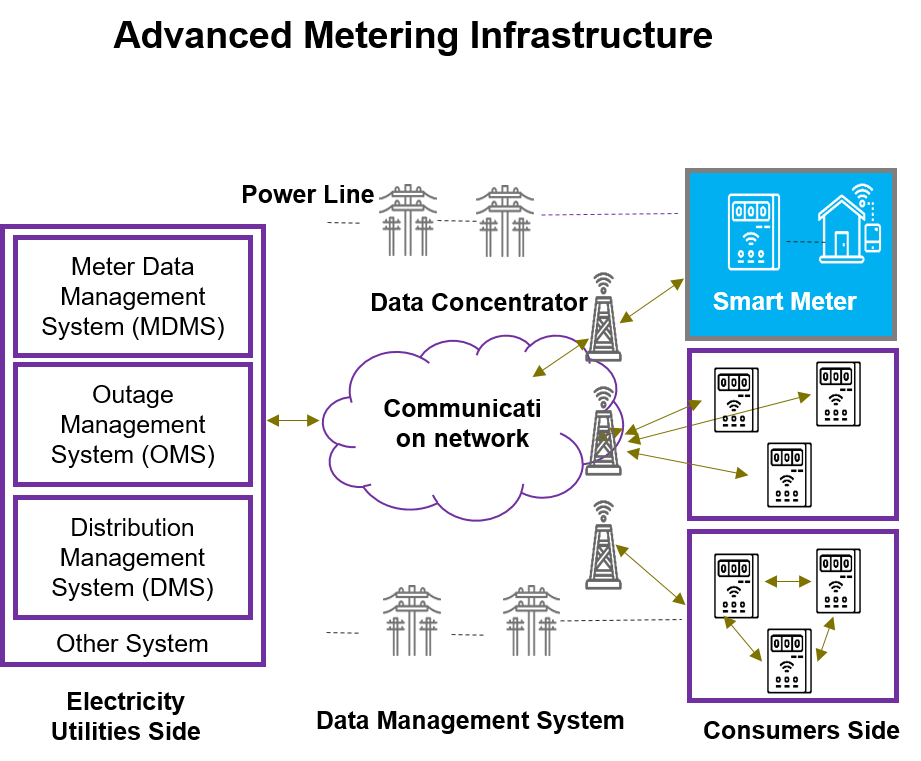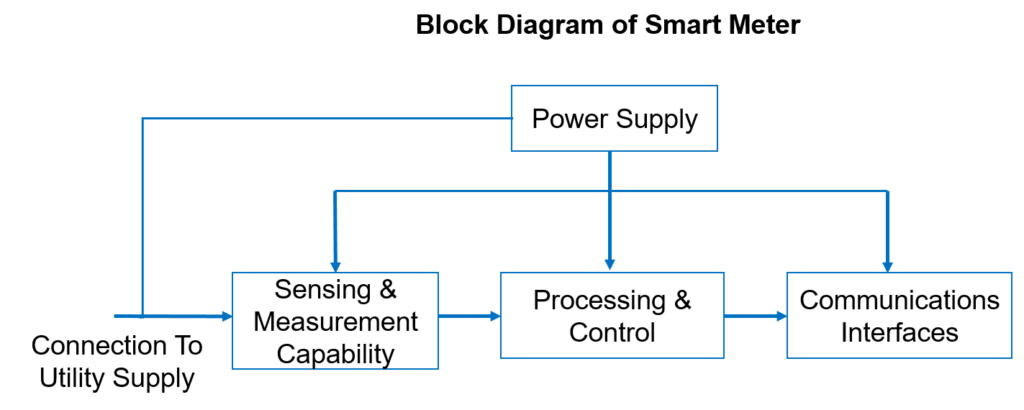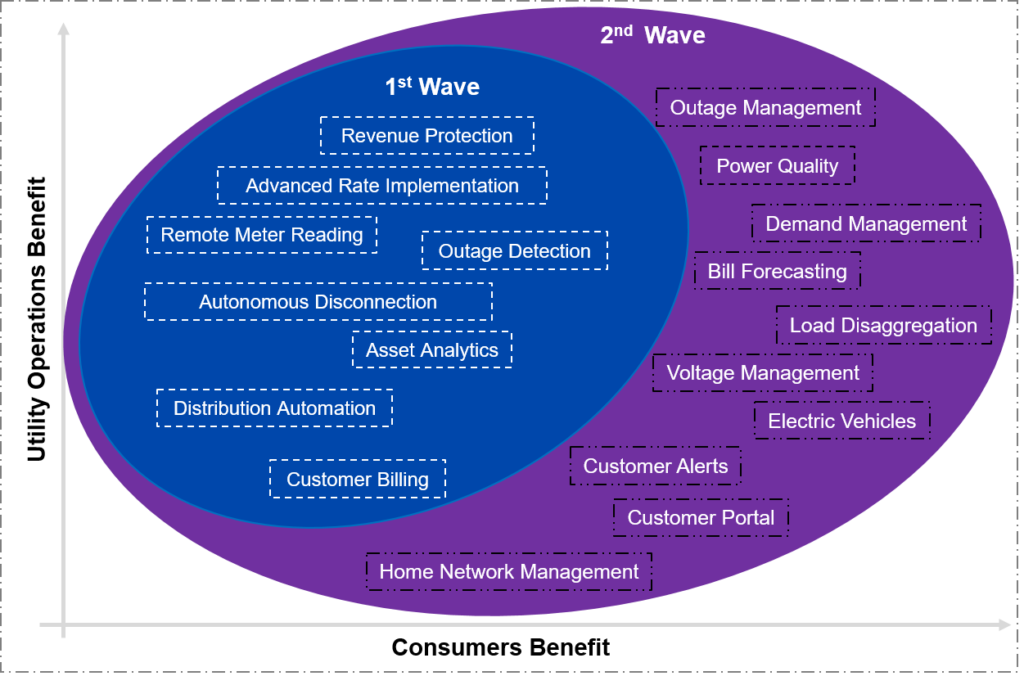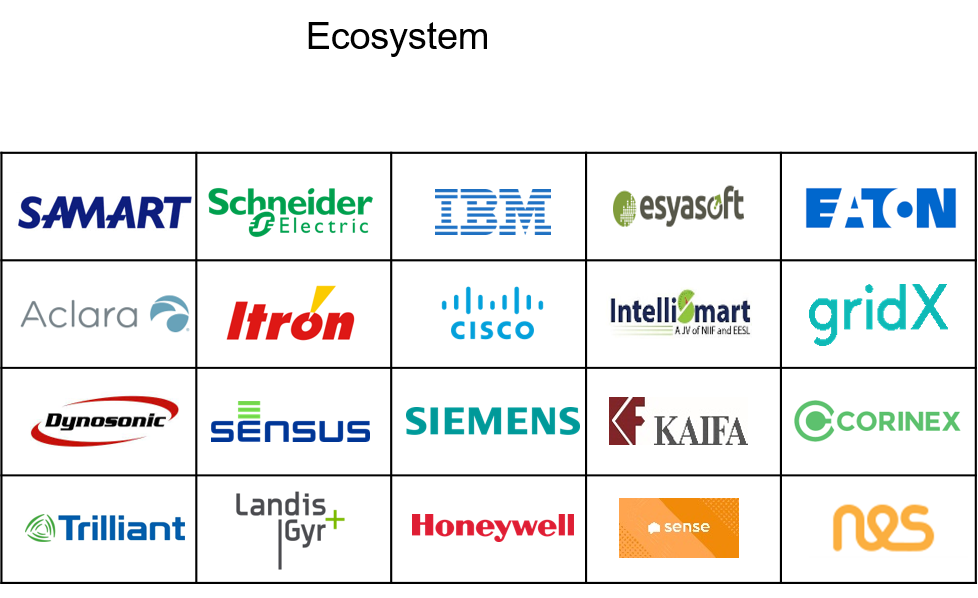Advanced Metering Infrastructure (AMI) is an integral part of a smart grid ecosystem, which provides bidirectional communication between utilities and consumers. AMI encircles the technologies related to smart meters, communication networks, and data management systems, which present multiple features that enhance grid efficiency, reliability, and sustainability.
Smart Meters present innovative tariff structures and send precise bills based on meter information, thus lowering customers’ trouble and increasing user loyalty. Smart metering is the most important approach to achieving the smart grid target.
The article explores the architecture of the Advanced Metering Infrastructure system, what smart metering is, the block diagram of smart meters, and how smart meters communicate. It will also examine open research challenges, analyze smart meters’ current market presence, and conclude.
Advanced Metering Infrastructure
The Advanced Metering Infrastructure (AMI) includes physical and virtual elements, such as sensors, monitoring systems, smart meters, management systems, and communication networks, that enable a two-way information flow between customers and utilities on power prices and consumption, including the time and amount of electricity utilized.
AMI is an integrated system of smart meters, communication networks, and data management systems, where the meters collect customer data at regular periods. The data generator from the smart meters is in massive amounts, so it delivers the data to a local data concentrator, from which the utilities will backhaul this data to its Meter Data Management System (MDMS) to assist customers billing and load forecasting. The Outage Management System (OMS) and Distribution Management System (DMS) further utilize this data to monitor, control, and enhance capabilities by maintaining real-time conditions in the grid if any system disturbances occur by automatically isolating or rerouting the power flow. The Advanced Metering Infrastructure data is further used to enhance customer service quality by using feedback, customizing pricing, or conserving voltage reduction in times of emergency.

Figure 1. Understand Advance Metering Infrastructure
What is a Smart Meter?
A smart meter is integrated with communication capabilities that monitor electricity consumption in real-time and share the collected information with utility companies. A smart meter helps understand the electricity grid’s position, enhancing the execution and quality of service for customers. Further, it helps users regulate their usage by selecting the best tariff for their needs and reducing the amount of energy they use by allowing them to understand how their usage affects their electricity costs.
Smart Meters have a telecommunications interface for remote communication between the central and meter systems. It allows remote reading and operations, such as sending new tariff tables, modifying the parameters associated with the contracts and the meter configuration, and operating the internal switch. Data collected from such devices allows other digital technologies, such as edge computing, cloud computing, artificial intelligence, and big data, to be used for network operation and exploitation.
Block Diagram of Smart Meter
Smart meters include a combination of hardware, software, and calibration systems. Metrology, security, and communication are the core elements of smart meters. Below is a basic block diagram of a smart meter.

Figure 2: Block Diagram of Smart Meter
Power supply: The power supply powers the meter’s circuitry, provides battery backup, protects against transients, and more. It uses a switched-mode technique, which ensures the highest efficiency level and reduces the current drain caused by smart meters.
Sensing & Measurement Capability: A smart meter measures the utility used. It requires reliability and accuracy. To improve efficiency and error rate, the measurement system utilizes digital sensors instead of analog sensors.
Processing & Control: The system uses a microcontroller to provide the processing for formatting the data, processing it, and converting it into the required formats needed for the interfaces. The processor manages the sending and receiving of data and commands over the various wireless communications interfaces.
Communications Interfaces: The smart meter needs to communicate the information back to the utility supplier for billing and management of their smart grid. It also needs to provide information to the user on a smart energy monitor or In-Home Display, IHD. A variety of different communications methods can be used for this, including cellular communications, power-line communications, ZigBee, etc.
How do Smart Meters Communicate?
Multiple smart meters gather data from many premises and then send it to the metering gateway. Smart meters can use many communication technologies, such as wired protocols (Ethernet, Power Line Communication (PLC), Meter Bus (M-Bus)) and wireless protocols (Wireless Meter-Bus, LoRaWAN, MIOTY, ZigBee, Wi-Fi). After receiving data from multiple smart meters, the metering gateways send it to the cloud for processing.

Figure 3: Smart Meter Communication Architecture
The backend application plays a major role and acts as a central hub for data collection, processing, and analysis. It gathers energy usage data from individual clients’ sub-meters, performs analytics to identify usage patterns, and allows utilities to optimize grid operations. The backend application allows accurate billing based on actual usage, which supports remote management of meters and ensures the security and privacy of the collected information.
Key Enabling Technologies for AMI
Many technological advancements, such as IoT, AI, blockchain, and 5 G, can be integrated into smart meters. This further changes how energy consumption is monitored and enhances the energy management system.

Figure 4: Key Enabling Technologies
Internet of Things (IoT): By implementing IoT in smart meters, it collects real-time data and sends it to utility companies for further processing. IoT helps in real-time monitoring so that regular maintenance can be done.
Artificial Intelligence (AI): AI helps smart meters improve communication by communicating with other linked devices and systems. It also helps detect errors and enhances the privacy and security of the billing system.
Blockchain Technology: It allows peer-to-peer energy exchange, by creating a decentralized and transparent platform for energy transactions, which improves cybersecurity.
5G Connectivity: 5G enhances smart metering connectivity by providing high-speed, low-latency communication for real-time data transmission. It permits remote monitoring, control, and optimization of smart meters, supporting efficient energy management and grid operations.
Advanced Metering Infrastructure: Key Innovation Areas
Smart meters face challenges in data security, communications, and management. To solve these challenges, many innovations are being made in these sections, which are given below.
- Data Security: Many devices collect and transmit detailed energy usage data; they can be responsible for unauthorized access, showing sensitive information about users’ habits and lifestyles.
- Cipher key leakage prevention: The University of Southwest Petroleum is developing a statistical analysis solution for encrypting data aggregation.
- Hybrid encryption with precomputation: The University of Quebec developed an advanced hybrid encryption technology that includes a precomputation procedure to protect a smart metering network and allow encryption and decryption.
- Data Communication: Smart meters include limited bandwidth from huge amounts of data, which causes interference from signals in urban cities and the need for security measures to protect private customer information.
- Scheduling a network resource: Yanshan University is working to provide a network resource scheduling solution with edge calculation to secure reliable communication data transfer with a minimum packet loss rate on the demand side of an intelligent power grid.
- IBAMCI integration with LAN: Tennessee Tech University developed an internet-based advanced metering and control infrastructure (IBAMCI) integrated with LAN and internet/cloud-based data management and control server to increase the utility network bandwidth.
- Data Management: Many utility companies and energy providers for smart meters face many challenges in collecting, storing, and utilizing the vast amounts of data generated by devices.
- Edge-Fog-Cloud computing: Bucharest University of Economic Studies proposed a process in which they divide the applications between Edge, Fog, and Cloud layers. Then, they design their interactions and distribute the functioning between the layers to reduce the communication latency, response time, resource load, and utilization.
- Privacy-Preserving Data Aggregation and Management Scheme (PATM): Chongqing University proposed a five-layer smart-meter architecture for efficient data aggregation and management. In the architecture, the tamper-evident nature of Blockchain is utilized for effective data management.
Advanced Metering Infrastructure: Deployment Trends
The figure below represents AMI deployment in the first and second waves. The utilities’ first wave of deployment is still in the developing phase and is assumed to become fully useful by the end of 2025. The utilities are trying to implement the second wave, as its deployment will give direct consumer benefits in addition to the first wave benefits.

Figure 5. AMI deployment
Market Insights
The Smart Metering market is observing activity, with various companies collaborating to provide innovative solutions. Key players such as Adani, Airtel, KAIFA, GridX, and others have introduced platforms that integrate smart meters for various applications. The market insights section includes information related to prominent players and recent activity in the domain.
Prominent Players
The smart meter technology industry consists of many established, active companies contributing to advancing efficient and sustainable energy management solutions.

Figure 6: Key players of advanced metering infrastructure
Advanced Metering Infrastructure: Recent Activities
Various companies are doing partnerships in this sector to meet the increasing demand for energy efficiency, observe regulatory requirements, and deliver more value to consumers through advanced functionalities like real-time data analysis and remote monitoring.

Table 1: Market Activity
Advanced Metering Infrastructure: Conclusion
The Advanced Smart Infrastructure, which includes data management systems, communication networks, and smart meters, provides a developing approach to energy management.
The communication protocols allow real-time data exchange between utilities and consumers through cellular, RF mesh, or power line networks. Key innovation areas, such as data security, data communications, and data management, ensure the integrity and efficiency of energy data. As these innovations continue to change, smart meters empower consumers and lay the foundation for a secure, strong, and data-driven energy future. In the future, they will work on advanced data analytics with AI and ML, integration with IoT for smart home applications, and continued grid modernization efforts.